Introduction
This document describes the Hydrogen Ontology (HOLY), a domain ontology for the hydrogen market, which aims to provide conceptual information of the current status and potential developments in the hydrogen market. Its target audience includes industrial, governmental, and research institutions that require continuous monitoring of market developments to evaluate and adjust their strategies. In its current version, which focuses on Polymer Electrolyte Membrane Fuel Cells (PEMFCs), it is designed to classify information concerning the composition of PEMFCs, their use, manufacturers, geographic areas, indicators, and projects. Conceptualizing market requirements is done by providing extensions to other areas of interests such as the organization domain, geo-location, indicators, project schemas, and applications.
The ontology is intended to structure market-relevant domain information for the hydrogen market in an accessible format and provide a generic, reusable core for expansion in different areas along the hydrogen value chain or even the use of certain content patterns for other market domain ontologies.
Following the Linked Open Terms Framework, HOLY was created by integrating technical domain knowledge with established business models. According to this approach, the ontology's requirements are identified in the specification stage. In the conceptualization stage, the problem and its solution are explained through a conceputal model. Existing ontologies are identified in the integration stage and are then integrated into the ontological structure. The final stage, implementation, implements the ontology in RDF or another ontology language and evaluates errors in syntax and lexicon.
Additional information regarding the HOLY project can be found on the HOLY website. If you would like to contribute to HOLY, please contact the Future Engineering Group.
Entity Naming Convention
For the labeling of entities belonging to the namespace HOLY, the following naming conventions from Open Biologican and Biomedical Ontology Foundry (OBO) [1, 2] were used:
-
use
rdfs:label for the primary label
-
include exactly one
rdfs:label for every declared entity (e.g., class, property)
-
use spaces to separate words. Do not use CamelCase, do_not_use_underscores
-
avoid extra spaces between words, or at the beginning or end of the term label
-
spell out abbreviations. Abbreviations can be included as a separate property.
-
make the primary labels to be as unambiguous as possible. Remember, your ontology may be used in a different context than that for which it was originally intended. Remember also of course that the label should be unambiguous without looking at parent terms
-
labels should be unique within an ontology
-
Prefer singular nominal form
In addition to the above-mentioned naming conventions, skos:altLabel was used to provide synonyms for entities and all words in primary labels were capitalized.
Namespaces
The namespace for the Hydrogen Ontology is
http://purl.org/holy/ns#
and the preferred prefix is
holy.
The Hydrogen Ontology uses terms from other vocabularies. The set of namespaces from those other vocabularies is displayed in the table below.
Namespaces Description
This section provides acknowledgement to the frameworks used for providing extensions to HOLY. A brief description of each namespace is provided followed by its implementation in the Hydrogen Ontology.
RDFS: The Research Description Framework Schema is an extension of RDF and allows the definition of hierarchical structures common in knowledge graphs such as classes, subclasses, ranges between classes, properties, sub-properties and domains within a graph modeled with RDF. In the ontology, RDFS is used for defining class names and the class structure.
SKOS: Simple Knowledge Organization System is a data model for sharing and connecting different organization systems with each other. An organization system can be one or multiple taxonomies, classification schemes or thesauri. The Hydrogen Ontology uses SKOS in annotation properties to define and comment content and annotate keywords and examples.
The Organization Ontology (org): The Organization Ontology provides a logical structure for linked company information across numerous domains including certain identification of roles and memberships. The Organization Ontology is used in the Hydrogen Ontology for building relationships between classes in order to identify the geographical location of primary sites, sites and membership relations in terms of project cooperation.
The Registered Organization Vocabulary (rov): The Registered Organization Vocabulary is classified by the Ontology Engineering Group as an extension of the Organization Ontology. The extension concerns the use of international classification standards such as NACE, SIC07 and ISIC4 for expressing economic activities and is used in the organization class of the Hydrogen Ontology.
The euBusinessGraph (ebg): The euBusinessGraph expands the area of economic activity integrating categorizing for start-ups while simultaneously covering explicit data for company registration. It is an extension of the Registered Organization Vocabulary and is used in the organization class of HOLY.
Schema.org: Schema.org provides schemas for structured data coming from the internet. The schemas on Schema.org range from a variety of different subjects including organizations, products, projects and places. The Hydrogen Ontology specifically embeds schema:Project and schema:ResearchProject in its project class.
Metadata4Ing: The Metadata4Ing Ontology (m4i) classifies science-related project activities within the area of engineering and neighboring sciences. It was released in February of 2022 and was created by a working group of the NFDI Consortium. It serves as an extension to the schema:Project class. In the Hydrogen Ontology, object properties of Metadata4Ing are used to illustrate relationships between projects and organizations.
DBpedia: DBpedia is a large, open-source cross-domain ontology inhabiting over 4.000.000 instances in its structure whose environment can be accessed with SPARQL queries. The Hydrogen Ontology inhabits DBpedia instances to enrich its structure.
Dublin Core: Dublin Core is a vocabulary of standard classes and properties for describing resources that facilitate the discovery of electronic resources akin to a library card catalogue.
Description and Commentary
The six core classes of the Hydrogen Ontology HOLY are org:Organization, schema:Project, holy:Product, holy:Application, holy:Indicator and holy:GeographicMarket. This structure is inspired by the Porters 5 Forces framework and market segmentation approaches to ensure a relevant, market-oriented structure. In addition, a top-down approach within the necessary classes is applied to provide a hierarchy which allows clustering from general to specialized.
The internal structure of the classes org:Organization and schema:Project are hereby completely built from extended structures of existing ontologies from The Organization Ontology, the Registered Organization Vocabulary, the euBusinessGraph, Schema.org, the Metadata4Ing Ontology and the DBpedia Ontology.
The classes holy:Product, holy:Application, holy:Indicator and holy:GeographicMarket contain taxonomies concerning composition of products, use cases, types of projects, economic indicators for markets and companies, and location differentiation. These taxonomies were specifically created for the Hydrogen Ontology.
HOLY was designed to be compatible with Natural Language Processing (NLP) methods. Through the properties skos:example, skos:altLabel, and skos:definition, which describe each class, it includes a semantic component in its structure.
The Organization Layer
Organizations must be classified since they act as direct or indirect participants within an economic environment. Hereby, organizations can take different roles from being an active manufacturer or service provider to being an indirect player focusing more on governmental or administrative activities within a market.
The Organization layer of HOLY uses The Organization Ontology as its foundation since it provides an established and neutral classification scheme for classifying organizations in their different fields of economic activity. The selected classes supporting this structure are hereby org:Organization and org:FormalOrganization.
To provide an in-depth classification using classifiers such as NACE, ISIC or SIC, the extending object properties from The Registered Organization Vocabulary have been implemented. To expand the classification of businesses even more, data properties of the euBusinessGraph were used.

Taxonomy of org:Organization in HOLY
Properties related to Organization
org:Organization has object properties connecting it to the main classes holy:Product, holy:Application, schema:Project, holy:GeographicMarket, and holy:Indicator. The object properties linking holy:GeographicMarket and org:Organization reveal the location of a company’s economic activity or that of one of its subsidiaries. Properties relating to holy:Product and holy:Application identify manufacturers of products or application providers. Object properties to schema:Project discloses partnerships in previous, current or future projects. The relationship to the class holy:Indicator links performance indicators.
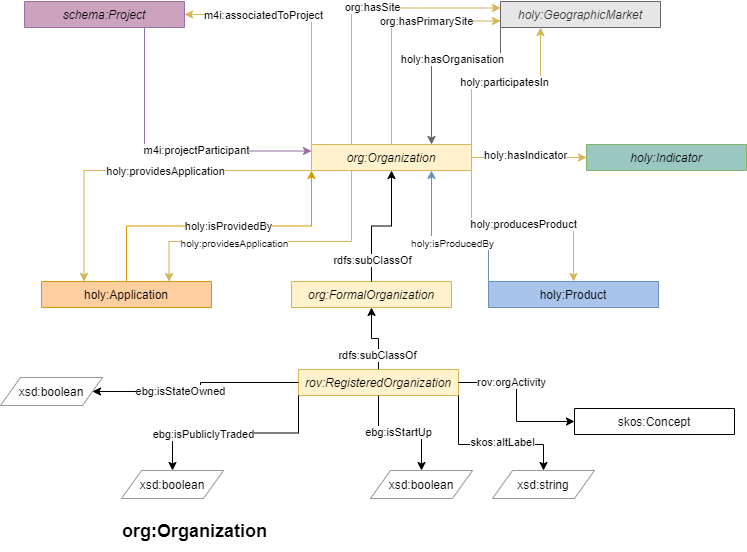
Properties going from org:Organization to org:Organization illustrate intercompany relationships such as being a subsidiary or being linked to a company through other business relations.
The Project Layer
Projects often indicate in which stage of application a certain technology is. To classify information concerning projects, the class schema:Project from the Schema.org framework was implemented. The underlying taxonomy divides schema:Project into the state and the purpose of a project.

Taxonomy of schema:Project in HOLY
Properties related to Project
schema:Project has relationships to the classes org:Organization, holy:Application, holy:Indicator, holy:Product, and holy:GeographicMarket.
Object properties relate to the outcome of a project, allowing classification by either being related to a product (holy:relatesToProduct) or an application (holy:relatesToApplication). Object properties from the Megadata4Ing ontology connect organizations with projects (m4i:inProject/m4i:projectParticipant). The object property holy:hasIndicator to the class holy:Indicator takes criteria such as funding into account. The object property connecting to holy:GeographicMarket defines the location of a certain project.
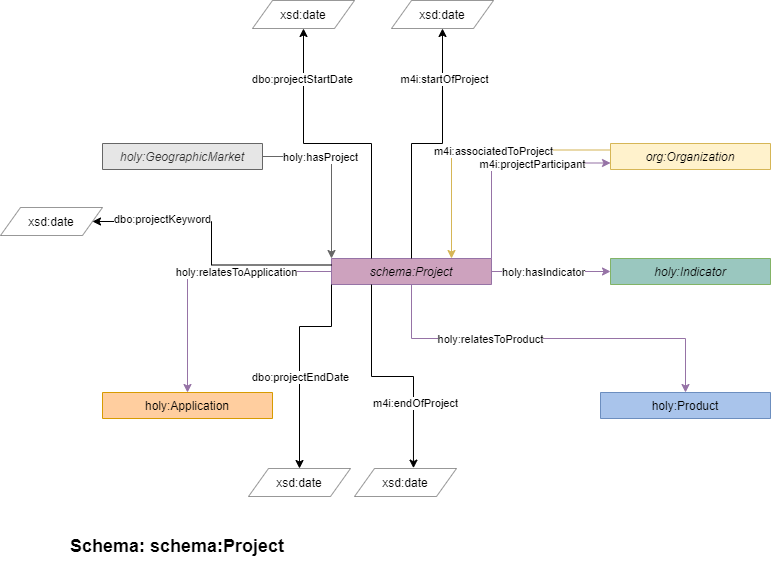
The Product Layer
For representing the hydrogen market, products and technologies play an essential role. The terms ‘product’ and ‘technology 'are treated as substitute terms in this ontology based on their interchangeable use in different information sources (such as journal articles, press releases, company sites, and reports). Regarding the current focus on PEMFCs, products other than PEMFCs currently have no further component classes describing their composition.
The schema for holy:Product is organized in six different layers. The first subclass layer includes a separation between hydrogen products and substitute products as well as their respective components. For hydrogen products, products are separated in different value chain positions and product types.

Taxonomy of holy:Product in HOLY
Properties related to Product
holy:Product relates to the classes org:Organization, schema:Project, holy:Indicator, holy:Application, and holy:GeographicMarket. The object property holy:isUsedIn to the class Application and its schema identifies use cases. The object property holy:producesProduct shows the producer of a product or technology. The object property holy:relatesToProduct creates a connection to show the participation of a product or technology in a certain project. holy:hasProduct and holy:hasIndicator connect the Product class with the main classes holy:Indicator and holy:GeographicMarket.
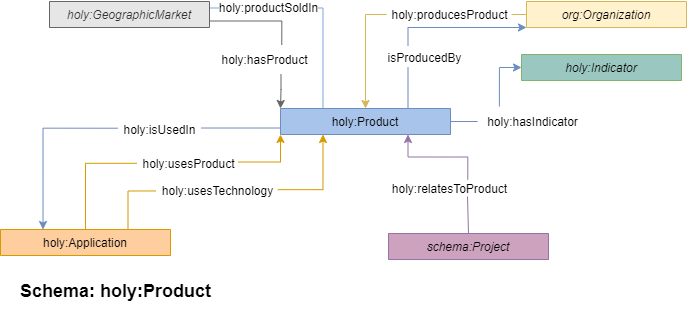
The Application Layer
It is intended to know the use case for certain products and technologies. Therefore, the class structure of holy:Application aims to provide a comprehensive list of possible applications.
holy:Application’s taxonomy is similar to holy:Product. Its first layer differentiates between mobile and stationary application types. Following a top-down approach, classes lower down in the taxonomy for holy:Application deliver more detailed classes concerning different types of mobile and stationary applications.
Based on the PEMFC focus, the subclass structure for mobile applications is currently more advanced than the structure below holy:StationaryApplication.
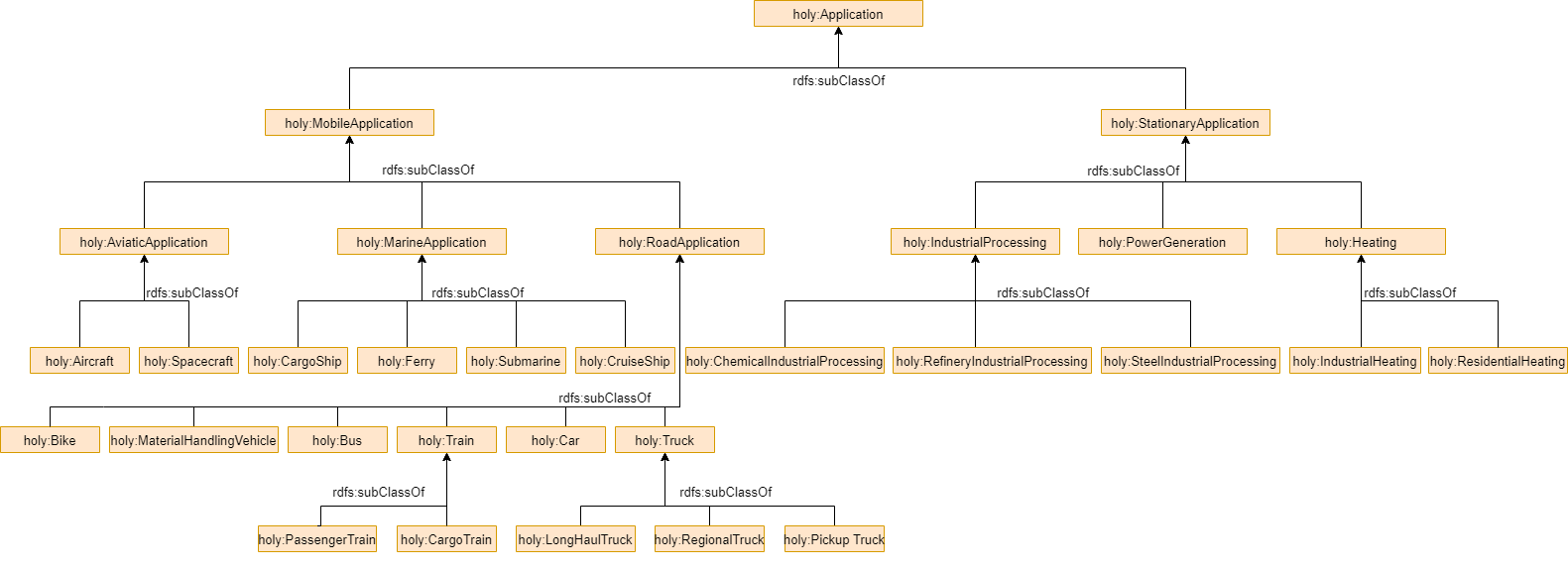
Taxonomy of holy:Application in HOLY
Properties related to Application
holy:Application relates to the classes org:Organization, schema:Project, holy:Indicator, holy:Product, and holy:GeographicMarket. The object properties holy:usesTechnology and holy:usesProduct identify if an application is using a technology or a product. A connection to schema:Project via holy:relatesToApplication connects applications to ventures. The object property holy:applicationSoldIn to holy:GeographicMarket serves as an addition to holy:hasApplication since some components or technologies might be not available for sale in certain markets.
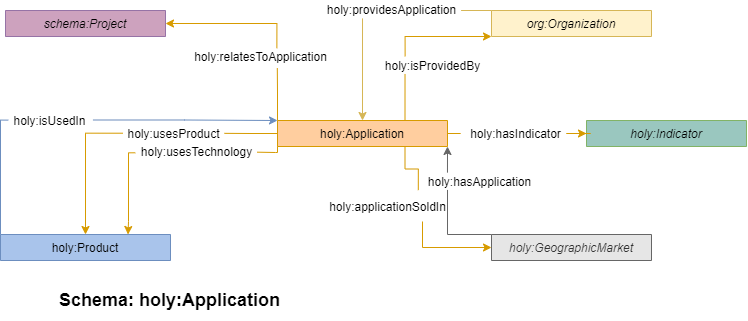
The Indicator Layer
To provide a structure covering competitiveness and development, the consideration of indicators concerning market size, investment, and social development is needed.
The taxonomy for holy:Indicator includes classes for investment, employee size, market share, market size and revenue, entry barriers, patent, and trend.

Taxonomy of holy:Indicator in HOLY
Properties related to Indicator
holy:Indicator has relationships to the classes schema:Project, org:Organization, holy:Product, holy:Application, and holy:GeographicMarket. The incoming object property is holy:hasIndicator.
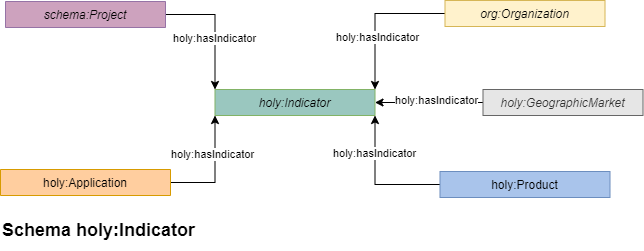
The Geographic Market Layer
To store geographic data, the addition of the class ‘GeographicMarket’ allows geographic segmentation of the main classes and its underlying structure. To do so, holy:GeographicMarket is mapped with the DBpedia ontology to allow a precise classification.
The taxonomy of holy:GeographicMarket consists of two subclasses from Schema.org (schema:continent and schema:country).

Taxonomy of holy:GeographicMarket in HOLY
Properties related to Geographic Market
holy:GeographicMarket relates to the classes schema:Project, holy:Indicator, holy:Application, holy:Product and org:Organization to allow geographic mapping of the instances of other classes. holy:GeographicMarket also has an object property linking its two subclasses. The object property dbo:continent allows mapping with DBpedia to query missing geographic information from the DBpedia ontology.
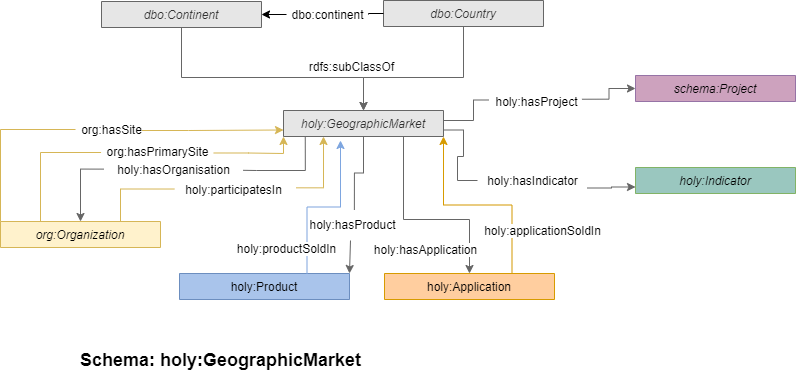
Annotation Properties
Annotation properties from RDFS and SKOS have been used to describe semantic information in the Hydrogen Ontology. The annotation properties integrated in HOLY's classes, together with a description and example from the class holy:Truck, are as follows:
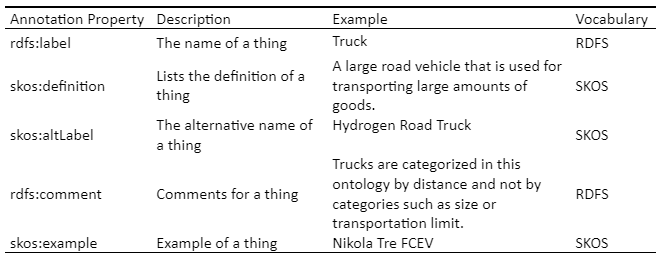
The references are identical to information from the documentation of RDFS and SKOS.















